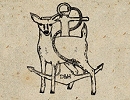Contact Seller
Doe And Hope
Tel07729 213013Please quote Antiques Atlas.


 Large Sea Beach Picture
Large Sea Beach Picture
 1943 Large Marquetry Picture The Slave Market
1943 Large Marquetry Picture The Slave Market
 John Everett Millais "Cherry Ripe"
John Everett Millais "Cherry Ripe"
 Chromolithograph Wellington At Waterloo
Chromolithograph Wellington At Waterloo
 Needlework Tiger
Needlework Tiger
 Mark Ingram Beautiful Large Painting on Canvas. c1960
Mark Ingram Beautiful Large Painting on Canvas. c1960
 Set Of 6 Antique Botanist's Specimens, English
Set Of 6 Antique Botanist's Specimens, English
 Antique Painting Light
Antique Painting Light
 Pierre de Clausade painting "De Marais"
Pierre de Clausade painting "De Marais"
 Early C20th Large Scale Tang Horse Brass Rubbing.
Early C20th Large Scale Tang Horse Brass Rubbing.
 Early 19th cent. aquatint R G Reeve of racehorse
Early 19th cent. aquatint R G Reeve of racehorse
 Feather Work Study Cockfighting Pictures
Feather Work Study Cockfighting Pictures
Non UK callers :
+44 7729 213013
19thC Verre Églomisé Armorial Royal Coat of Arms


The superb quality nineteenth century verre Églomisé armorial panel of exquisite detail and execution, the whole vibrantly painted showing the Royal coat of arms of the United Kingdom, on an ebony ground and mounted in a glazed frame, survives from the middle of the nineteenth century and the early Victorian period.
The plate does have some minor areas of wear, but the majority, probably 75% remains in very good condition. There is a variety of degrading to the black background of the main piece with some chipping to the black background towards the bottom which we rather like as it serves to give the piece its history. The central decoration has minimal wear evident. The frame is a later addition with the back of the panel having been secured with plasterboard to provide more stability so the whole is rather heavy. Overall the piece is wonderfully original and there hasn’t been any restoration or meddling with so to speak.
The Royal coat of arms of the United Kingdom, or the Royal Arms for short, is the official coat of arms of the British monarch, currently Queen Elizabeth II.
The Royal Arms we see today have evolved over nine centuries, since Richard 1st (the Lionheart) chose a shield of three lions to represent the three areas England, Normandy and Aquitaine - which were associated with the English crown.
The shield is quartered, depicting in the first and fourth quarters the three passant guardant lions of England in the second, the rampant lion and double tressure flory-counterflory of Scotland and in the third, a harp for Ireland. The crest is a statant guardant lion wearing the St Edward's Crown, himself on another representation of that crown. The dexter supporter is a likewise crowned English lion the sinister, a Scottish unicorn. According to legend a free unicorn was considered a very dangerous beast therefore the heraldic unicorn is chained, as were both supporting unicorns in the Royal coat of arms of Scotland. In the greenery below, a thistle, Tudor Rose and shamrock are present, representing Scotland, England and Ireland respectively. The coat features both the motto of English monarchs, Dieu et mon droit (God and my right), and the motto of the Order of the Garter, Honi soit qui mal y pense (shame upon him who thinks evil of it) on a representation of the Garter behind the shield. The final significant change occurred when Victoria became Queen in 1837. As a woman she could not succeed to the throne of Hanover, so the shield of pretence was omitted from her Arms. Apart from changes in the initials of the Sovereign, the Royal Arms have remained the same ever since.
The Royal arms were created in various mediums including, textile, wood, stone, plaster, cast iron, paint and glass. The earlier Arms were often painted on wooden panels, but by the eighteenth century they were more likely to be on canvas. They were often painted by local sign writers and very crude. However, Arms could also be of very fine and high-end craftsmanship, as this one is, particularly when they were specifically designed as part of new architectural schemes. This particular example is also large for its type.
A hugely pleasing find that would have been very expensive indeed to commission.
SellerDoe And Hope
View all stock from
Doe And Hope

 Private dealer, By appointment only
Private dealer, By appointment only
The Onion Barn, Shoe Cottage,
15 High Street, Blunham,
Bedfordshire, MK44 3NL.
MK44 3NL
Tel : 07729 213013
Non UK callers : +44 7729 213013
Get directions to Doe And Hope
The plate does have some minor areas of wear, but the majority, probably 75% remains in very good condition. There is a variety of degrading to the black background of the main piece with some chipping to the black background towards the bottom which we rather like as it serves to give the piece its history. The central decoration has minimal wear evident. The frame is a later addition with the back of the panel having been secured with plasterboard to provide more stability so the whole is rather heavy. Overall the piece is wonderfully original and there hasn’t been any restoration or meddling with so to speak.
The Royal coat of arms of the United Kingdom, or the Royal Arms for short, is the official coat of arms of the British monarch, currently Queen Elizabeth II.
The Royal Arms we see today have evolved over nine centuries, since Richard 1st (the Lionheart) chose a shield of three lions to represent the three areas England, Normandy and Aquitaine - which were associated with the English crown.
The shield is quartered, depicting in the first and fourth quarters the three passant guardant lions of England in the second, the rampant lion and double tressure flory-counterflory of Scotland and in the third, a harp for Ireland. The crest is a statant guardant lion wearing the St Edward's Crown, himself on another representation of that crown. The dexter supporter is a likewise crowned English lion the sinister, a Scottish unicorn. According to legend a free unicorn was considered a very dangerous beast therefore the heraldic unicorn is chained, as were both supporting unicorns in the Royal coat of arms of Scotland. In the greenery below, a thistle, Tudor Rose and shamrock are present, representing Scotland, England and Ireland respectively. The coat features both the motto of English monarchs, Dieu et mon droit (God and my right), and the motto of the Order of the Garter, Honi soit qui mal y pense (shame upon him who thinks evil of it) on a representation of the Garter behind the shield. The final significant change occurred when Victoria became Queen in 1837. As a woman she could not succeed to the throne of Hanover, so the shield of pretence was omitted from her Arms. Apart from changes in the initials of the Sovereign, the Royal Arms have remained the same ever since.
The Royal arms were created in various mediums including, textile, wood, stone, plaster, cast iron, paint and glass. The earlier Arms were often painted on wooden panels, but by the eighteenth century they were more likely to be on canvas. They were often painted by local sign writers and very crude. However, Arms could also be of very fine and high-end craftsmanship, as this one is, particularly when they were specifically designed as part of new architectural schemes. This particular example is also large for its type.
A hugely pleasing find that would have been very expensive indeed to commission.
Price The price has been listed in British Pounds.
Conversion rates as of 16/APR/2025. Euro & Dollar prices will vary and should only be used as a guide.
Always confirm final price with dealer. Phone or visit the website to buy, Free UK shipping.
Category Antique Pictures / Engravings / Art
Date c.1840-60
Early Victorian Antiques Material Glass
Origin English
Item code as155a1381
Status Sold
£1900.00 
$2518.83 
€2212.74 

$

€

Conversion rates as of 16/APR/2025. Euro & Dollar prices will vary and should only be used as a guide.
Always confirm final price with dealer. Phone or visit the website to buy, Free UK shipping.
View all stock from
Doe And Hope

 Private dealer, By appointment only
Private dealer, By appointment onlyThe Onion Barn, Shoe Cottage,
15 High Street, Blunham,
Bedfordshire, MK44 3NL.
MK44 3NL
Tel : 07729 213013
Non UK callers : +44 7729 213013
Get directions to Doe And Hope
You may also be interested in
 Large Sea Beach Picture
Large Sea Beach Picture
 1943 Large Marquetry Picture The Slave Market
1943 Large Marquetry Picture The Slave Market
 John Everett Millais "Cherry Ripe"
John Everett Millais "Cherry Ripe"
 Chromolithograph Wellington At Waterloo
Chromolithograph Wellington At Waterloo
 Needlework Tiger
Needlework Tiger
 Mark Ingram Beautiful Large Painting on Canvas. c1960
Mark Ingram Beautiful Large Painting on Canvas. c1960
 Set Of 6 Antique Botanist's Specimens, English
Set Of 6 Antique Botanist's Specimens, English
 Antique Painting Light
Antique Painting Light
 Pierre de Clausade painting "De Marais"
Pierre de Clausade painting "De Marais"
 Early C20th Large Scale Tang Horse Brass Rubbing.
Early C20th Large Scale Tang Horse Brass Rubbing.
 Early 19th cent. aquatint R G Reeve of racehorse
Early 19th cent. aquatint R G Reeve of racehorse
 Feather Work Study Cockfighting Pictures
Feather Work Study Cockfighting Pictures







